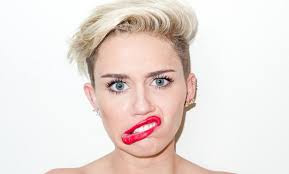Miley Cyrus is an American singer song writer who has been in the public eye since a young age.
Born in Nashville, Tennessee, the daughter of a famous country musician, Miley incorporates music from her roots with a combination of Pop on many of her albums, two genres of music which do not conventionally fit.

Cyrus became an icon for young girls around the globe after the success of her well known teen sitcom, however many were surprised to see a drastic change in her appearance and persona, starting with the release of her 2010 album 'can't be tamed'. From here on out, Cyrus created increasing controversy in the public eye surrounding her appearance and edgy behaviour.
The public were surprised by Miley's drastic change from the 'good girl' image to a 'rebellious teen'.
Miley goes from writing innocent and relatable songs in her first albums, to ones focusing on the subject of recreational drug use, extremely controversial considering many of her fans consist of young, teenage girls.
Inter textual References
- La di da di- Slick Rick & Doug E Fresh. Cyrus' track 'we can't stop' features a sample from Slick Rick & Doug E Fresh's New School Hip Hop & Beat boxing track La di da di. This is incorporated into Cyrus' pop single. This is an example of bricolage, as Cyrus is using sample's from different genres and incorporating them into her tracks.
- Dirty- Christina Aguilera: Christina Aguilera was cited as possible inspiration for the sexualization of Cyrus' 'We can't stop' music video. The infamous 'slut drop' has been seen in many contemporary artists work, such as Beyonce and Cyrus and is said to have gained popularity from Aguilera's 2002 single.
- Lady GaGa- Just Dance. Cyrus' video was also cited to have similarities to Lady Gaga's 2008 single, Just Dance which follows a similar story line and also includes references to sex and recreational drug use.
- SMS- 1980's hip-hop inspired track - Inspired by female rap trip salt-n-pepa.
Simulacrum
Miley cyrus' music hasn't just been released under one name. However, she has a variety of records branching from her TV programme Hannah Montanna. She has released albums under the names of Hannah Montana, Miley Stewart and Miley Cyrus. All three characters represent a pop artist, so who is the real Miley Cyrus? Furthermore, in recent years, Cyrus has changed her public image from that of 'disney sweetheart' to a 'teenage breakaway', we do not know if this is her real personality or whether she is simply building up a controversial character to sell her music and gain public attention.
Is this image real or is it simply a put-on performance to help her sell her albums?
In Hannah Montanna, Cyrus plays two characters, Miley Stewart and Hannah Montanna. We do not know if Miley Stewart is a representation of the real Miley or whether Miley Stewart is actually merely a fictional character who has no resemblance to the real Miley. This is made increasingly difficult to distinguish as her real-life father, Billy Ray Cyrus also plays himself in the TV programme. We do not know whether this reflects that Miley is actually playing herself or whether Billy Ray is also playing a fictional character simply acting as his character under his real name.
Pastiche
Miley's Instagram account consists of a variety of strangely edited and photo shopped images which to the majority of people make no sense. However, Cyrus may actually be using this media platform to make a mockery of other artists (pastiche) or to pay reference to other artists. She also pays homage to inanimate objects such as pizza on her page as is seen in some of the images below. Most noticeably, Kanye West seems to appear in many of her photo shopped images. Kanye, a renowned Hip Hop and RnB artist may be prolific to Cyrus, seen as her latest album, Bangerz is meant to feature samples from the Hip Hop genre and is a mash up of Hip Hop, Country and Pop. Cyrus is also thought to have created a remix of Yeezus track, 'Black Skinhead' with Kanye West in recent years. This is quite a drastic change, with Miley starting her career writing and performing Pop music based on a fictional TV programme for a young, teenage audience to recording explicit Hip Hop tracks with the likes of Jay Z. It seems by the looks of these photos that she is making a mockery of the artist and Hip Hop, by the way she is combining a bricolage of Country, Hip Hop and Pop on her album.
Cyrus takes something innocent, E.G: Teddy Bears and turns it into something more mischievous. In several of her videos and performances we see dancing, twerking teddy bears placed around images of drug use and drinking. This is another aspect of her work which makes her ever more controversial. This idea has also been used in other forms of mainstream media, such as in the film Ted, where something that is meant to be innocent is turned into something crude and quite inappropriate. Is Cyrus trying to create a new style by doing this?
Songs that have sampled tracks from Cyrus' album Bangerz include:
DJ Earworm- Living the Fantasy-From both We Can't Stop & Wrecking ball
Pokemon-Medley Theme
Vee Tha Rula, Tidal wave features Samples from Cyrus' Wrecking Ball
Cedric Gervais' remix of Adore You
Creation
Cyrus has written her own tracks, she has also co-produced several of her songs, as well as several being written for her and herself simply performing them.















